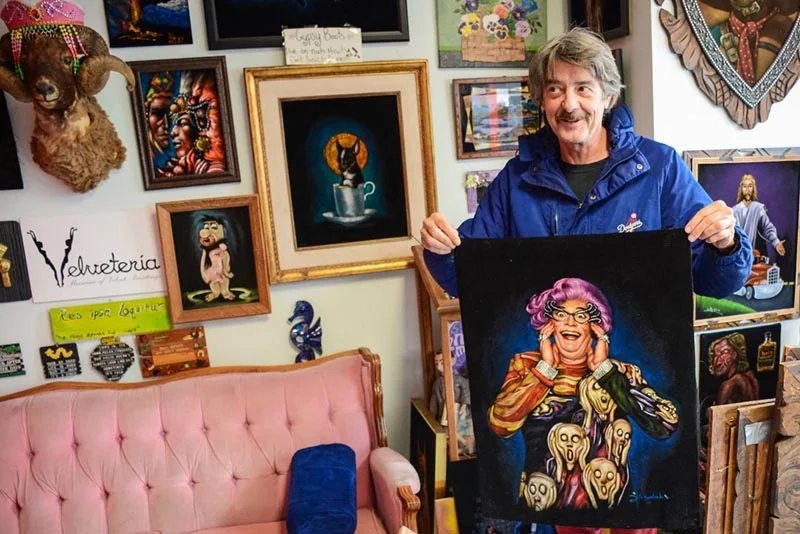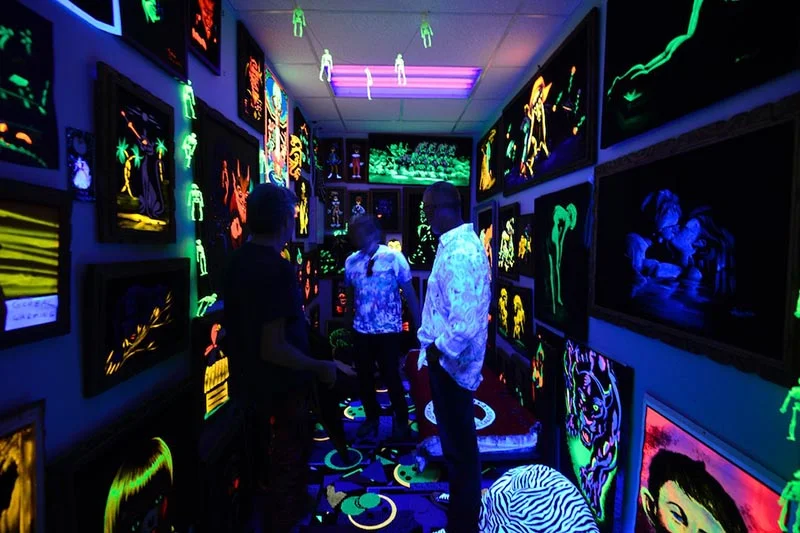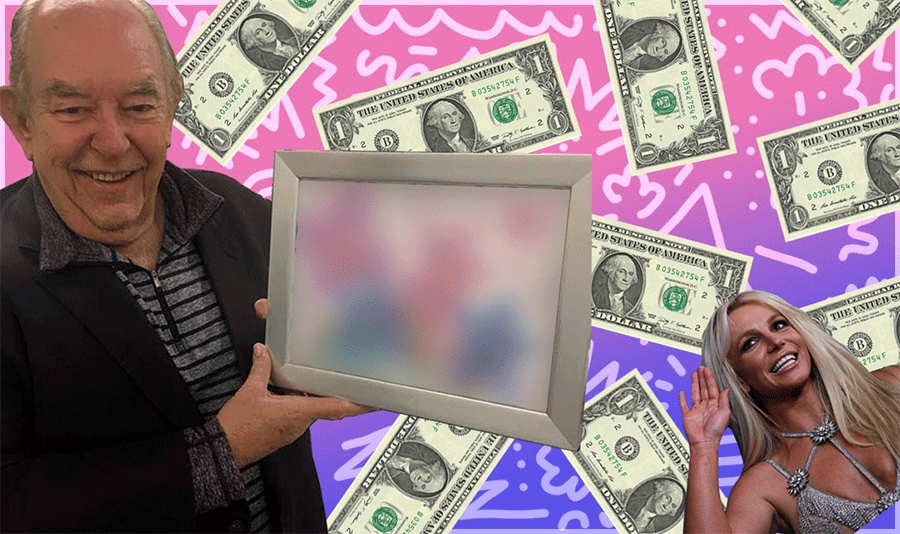Help Save Velvet Paintings
A Los Angeles museum struggles to keep its brick-and-mortar shrine to fabric art open despite tons of internet and media love.
By Jessie Schiewe
Image courtesy of Velveteria Museum
Update: Velveteria permanently closed on September 30 2019
Where can you find Jesus, Hulk Hogan, World War II soldiers, sad clowns, and a bunch of naked ladies all in one place?
At Velveteria.
With its pink shag rugs and tiger print carpeting, the Los Angeles museum is a mecca of kitsch, brimming with vintage ephemera, dusty taxidermy, and an oddball collection of more than 5,000 velvet paintings. And, after six years in business — 14, if you include the museum’s early years in Portland, Oregon — there is, understandably, nary an inch of free space left on any of its walls.
From its hallways to its bathroom, Velveteria is lined with kooky, occasionally crappy, and often surprisingly well-executed paintings constructed atop black, velvet canvases.
Many of them are vintage pieces— like the Elvises, the topless Polynesian women, the Black Power icons, and the menagerie of people’s pets — dating from the 1960s and 1970s.
Lots are also newer commissions, painted by artists the museum works with in Tijuana, Mexico. Usually more expertly crafted, they feature portraits of modern-day celebrities including Miley Cyrus, Caitlyn Jenner, Dog the Bounty Hunter, and Yoda.
There’s also a fair share of fantastical art hanging from the museum’s walls — and we’re not just talking about unicorn and Bigfoot paintings (although they have those, too).
There’s Anderson Cooper in a thong. A vampire-toothed Hillary Clinton. Donald Trump as a centaur. Dogs with third eyes.
Photo: Velveteria
From the Museum of Jurassic of Technology to the Museum of Death, the city of Los Angeles certainly has no shortage of weird museums — but Velveteria is easily its most trippy one yet.
And it needs your help.
The museum is experiencing financial troubles and has been struggling to keep its doors open since at least last summer. In June 2018, it started a GoFundMe campaign to raise $50,000. In nine months, it had only raised 5.6 percent of that amount.
Even though the internet is gaga for it and celebrities like Anthony Bourdain, Jay Leno, and Tom Green have given it ample press, Velveteria is in straights. Not enough customers are visiting the museum, and, according to its owner, even fewer are willing to pay the $10 admission price.
“For what this is, I should be getting 20, 30 people a day,” said Carl Baldwin, Velveteria’s 66-year-old founder and owner. “It’s just me and Iggy [Pop] here eating dog food, trying to stay alive.”
Among other things, Baldwin is a native Southern Californian, a former Vietnam War protestor, and a bleeding-heart liberal known for wearing funny hats, and, fittingly, velvet jackets. When he talks, he rambles, squishing his sentences with historical facts and pop culture zingers that are easy to miss because they’re so obscure and delivered at such a fast clip. He pokes fun at evangelists, has a history of getting kicked out of political rallies, and thinks that cops would benefit from taking LSD. And, more than anything else, he loves velvet paintings.
Carl Baldwin, the owner and founder of Velveteria Museum has a thing for art that doesn’t take itself too seriously. (Photo: Velveteria)
Baldwin’s introduction to the oft-considered tacky art form happened early on in his childhood thanks to his Uncle Charlie who had a velvet painting of a naked lady hidden in his closet “behind all his aloha shirts.” It was around 1958 or ‘59 when the young Baldwin discovered it, marking his first exposure to both art and the female body.
“So that was kind of a legendary thing in my life. It always stuck with me,” Baldwin told OK Whatever.
He saw many more velvet paintings (and, presumably, naked women) throughout the next few decades, but by the 1990s, they had all but vanished. No longer could you find garish portraits of Jimi Hendrix and tigers being sold on the streets. Once seemingly everywhere, velvet paintings had become but a distant memory.
“I hadn’t seen one in a million years and I thought, Whatever happened to them? This must be something else Ronald Reagan got rid of when he wrecked America.”
Baldwin began collecting them, throwing small pop-up shows at his home in Oregon that titillated his friends and excited even the most “boring” of people. Emboldened, he opened the first iteration of Velveteria in Portland in 2005. When he grew tired of the rain seven years later, he packed up shop and moved back down to sunny California where he’s been ever since.
(Photo: Velveteria)
Velvet paintings are no new thing. Beloved for the material’s unique ability to reflect light and absorb color, they have been popular since the Renaissance. Pitted against stark black backgrounds, the saturated images pop from their canvases, sporting a certain texture and a viscerality not often found in one-dimensional art.
Baldwin has witnessed, time and again, the unique effects that velvet painting can have on viewers. People laugh when they come to the museum. They hug. They give high-fives. Babies stop crying if you take them into the black light room. And some people can’t help but get turned-on. Once, while viewing the museum’s nudes, an elderly Chinese woman said to Baldwin, “Even at 80, you get the same feelings.”
That’s a big part of why he runs the museum.
“I enjoy doing this,” Baldwin explained. “It just brings down, I don’t know if it’s your defenses, but when you walk in here, you become like a child again, you know?”
It also helps if one has a sense of humor. Just because you’re in an art museum doesn’t mean you can’t laugh.
(Photo: Velveteria)
“You’ve got to understand the concept of silliness to get it. And if you don’t have that, man, what good is life?”
It’s a question worth asking and one that is partly responsible for keeping Baldwin in the velvet painting biz for so long. Not that he hasn’t considered packing up and giving up entirely either.
“Honestly, like, I have some property in Arizona and sometimes I think, man, maybe I should just go out there and wait for Jesus,” Baldwin said.
Future goals — along with the gargantuan task of selling off thousands of pieces of artwork — are what keep him in L.A. for now. Baldwin, who has already published a book, wants to put out another one, as well as release a documentary film about the museum. He’s also thinking it would be cool to have a travel show in which he scours the globe for more velvet paintings.
Money might be a bit tight right now, but Baldwin, it’s clear, is not ready to give up on his wonky utopia any time soon.
“I mean, if I can’t make it in freaking Los Angeles, the center of entertainment and thought and culture and everything, what am I going to do?”
He paused before continuing his thought.
“I’m just going to have to claw and scratch to keep this thing alive.”
(Photo: Velveteria)























A pop-up museum in Los Angeles tried to find the answer.